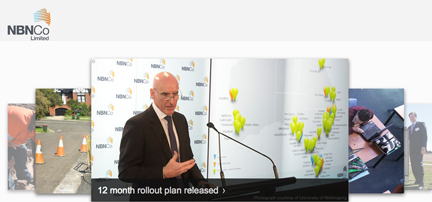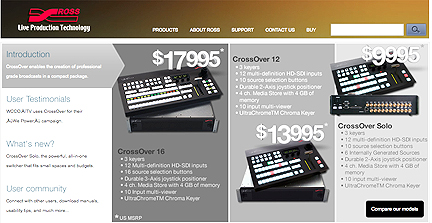-
International Datacasting Corporation (TSX: IDC), a leader in digital content distribution solutions for the world’s premiere broadcasters, will demonstrate high frame rate 2D and 3D technologies for digital cinema distribution at ShowEast, Miami, October 24-27th, 2011. International Datacasting will feature its state-of-the-art Pro Cinema Event Player (PCEP) capable of delivering high quality 2D and 3D images for digital cinema projectors. This latest technology decodes high frame rate and high resolution video for unparalleled image quality for alternative live content delivery. This enhances the audience experience, and increases consumer demand for watching sports, musical and theatrical events. The Pro Cinema Event Player also reduces the cost for theatre owners wanting to distribute 2D and 3D live content to numerous screens within a multiplex. The PCEP was recently unveiled at IBC 2011, as part of IBC’S Big Screen Showcase, which included a live demo in partnership with Christie. At ShowEast 2011, IDC is proud to partner again with Christie in demonstrating high frame rate video delivery using IDC’s PCEP and Christie’s Solaria digital cinema projectors. These state-of-the-art technologies will be featured at Christie’s Booth 615 in the “High Frame Rate Technology Zone”.
-
Work has begun on the rollout of the National Broadband Network in areas that are expected to cover more than half a million homes and businesses across Australia, when complete. NBN Co has released its inaugural 12-month construction outlook. The schedule lists the communities in each state and territory where work will begin between now and September 2012, as well as where work on the rollout of the network is currently underway. The plan names 28 new locations as part of the national rollout ,passing 485,000 premises where construction of the fibre optic network is expected to commence over the following 12 months. It also lists those sites where the rollout is already underway, accounting for a further 63,500 premises, including Second Release Sites. The 12-month schedule will be updated on a quarterly basis to include additional locations. Early next year the company will also issue a three-year indicative view of the rollout, to be updated annually until anticipated completion of the rollout in ten years time. On average, it is expected to take 12 months from the start of the fibre network rollout in a given area until individuals are able to receive high-speed broadband over the NBN. Once the network is built and ready for service, householders and business owners can purchase broadband and telephony packages from one or more of the 28 retail telecommunications providers that have signed up to offer services over the network. Twelve of these companies have already completed the necessary accreditation and on-boarding process in preparation for service delivery. The next phase of construction will also involve the rollout of the first stage of the transit network which will connect the different fibre access nodes to points where the traffic will be transferred to service providers. In this first stage NBN Co is planning to construct 149 transit links connecting 155 fibre access nodes, of which 30 are also points of interconnect. The company is nearing completion of a contract to build transit services over the next 12 months. To be completed over the next three years, the transit network is an important part of providing a National Broadband Network and will assist the roll-out of fibre, fixed wireless and satellite services. In addition to the basic rollout information, NBN Co is also providing additional data to telecommunications companies and Internet service providers in order to help them plan their investment programs and their marketing of services to consumers and businesses in each area.
- Research and Markets has announced the addition of the "Satellite TV in Europe & USA - Will The Future Of Satellite Be Guided By 3D?" report to their offering. HDTV is still the chief growth outlet for satellite operators in the TV market. TV homes are becoming better and better equipped to receive and record in high definition. The United Kingdom has the highest take-up of HDTV sets (almost all TVs sold in the country are now "HD ready"): 59 percent of homes are equipped with a compatible set, compared with 57 percent in the United States, 46 percent in France and 39 percent in Germany. HDTV take-up in Western Europe is a little behind the United States, although development of the market in North America did start a few years earlier (early 2000 in the United States, 2005 in Western Europe). Initially spurred on by video games and movie theaters, 3D is now besieging the TV market. 2010 was punctuated by numerous announcements of 3D channel launches, many featuring special one-off events and VoD services, and a few broadcasting non-stop. The number of 3D channels available on satellite is still limited and the catalog of 3D programs still lacking. All of the 3D VoD services launched by operators on the various networks ultimately offer much the same content. If the number of non-stop 3D channels and 3D VoD services were to continue to grow in the future, lDATE estimates that in 2015, the 3D service would take up around ten frequency channels on each of the leading DTH premium platforms, such as CanalSat in France, Sky in the United Kingdom and ones in the United States. For more information regarding this report, access this direct link.
-
Ross Video has announced significant price reductions for the CrossOver 12 and CrossOver 16 compact production switcher models. “The CrossOver product line has enjoyed significant sales growth this year and as a result we are now able to take advantage of even better quantity component pricing from our vendors,” said Nigel Spratling, Switcher Marketing Product Manager/Communications, Ross Video. “The CrossOver line has always been value priced, but the recent component price reductions have a significant impact on overall costs. At Ross we adhere to a fair pricing policy, so instead of keeping additional margin that these reductions bring we choose to pass such savings along to our customers.” Both versions are fully loaded systems with a feature set that is without comparison for switchers of this size.
Satnews Daily
October 24th, 2011
SatBroadcasting™ — This report includes new information from International Datacasting, Research + Markets, Ross Video
[SatNews] For those involved in the SatBroadcasting™ environment, here is important market segment news that could well be of interest to you...





